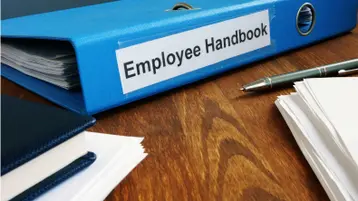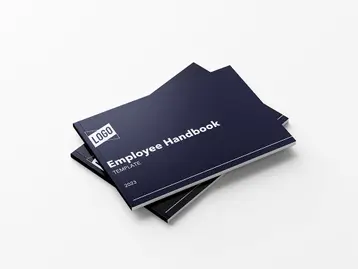
There are many benefits to an employee handbook. It can be a resource for employees in learning about company policies, benefits, and conduct that the business expects. A California employee handbook can also prevent miscommunication and serve as an employer defense if an employee complaint lands in court. A federal appeals court rejected the claims of a grocery store worker who sued his employer, claiming race and national origin discrimination. The man was fired after claiming he didn't know how or when damage to his tractor and trailer had occurred. Surveillance footage, however, showed that the worker had backed his tractor and trailer into a loading dock. The court noted that the company handbook prohibited dishonesty, expressly noting that "dishonesty alone may lead to employment termination." On the other hand, poorly written policies can cause problems. For example, in 2017, a judge refused to dismiss an employee's claim under the Family and Medical Leave Act. The court noted that the sections of the handbook explaining maternity leave and FMLA leave caused the employee to be confused as to how much leave she had available.
What to include in a California employee handbook
The National Federation of Independent Businesses (NFIB), an association of small business owners, recommends that employee handbooks include the following sections:
1. Introduction & welcome to the California employee handbook
This statement should include:
- A statement of welcome.
- A statement explaining that the handbook is not an employment contract and does not create a contractual relationship with employees. Some states view the employee handbook as an employment contract.
- A statement that employment is "at will." "At will" means the employer or employee may end the working relationship at any time without notice.
2. Workplace commitments
This statement should "include statements about equal employment opportunity and outline your company's policy prohibiting unlawful discrimination and harassment," NFIB says.
3. Company policies and procedures
This section should discuss the dress code, the employer's policies regarding the use of company property, privacy rules, drug use, social media, etc. It should also explain disciplinary action if an employee violates the policies.
4. Employment classification
"A section on employment classification and overtime rules is necessary," NFIB says.
5. Attendance policies
In this section, you should explain the company's work hours, attendance requirements, and policies on punctuality and absenteeism.
6. Leave policies
Describe leave, vacation, and time off policies. Include eligibility details. Remember to include leave required by local, state, and federal law.
7. Work performance
In this section, you should explain how employers will evaluate employee performance. This section can also include employer expectations for respect and courtesy in the workplace.
8. Discipline policy
Clearly explain what constitutes grounds for disciplinary action. Explain procedures used in employee discipline, including verbal and written warnings, probation, suspension, demotion, and discharge.
9. Employee health and safety
Outline policies and procedures for workplace emergencies, safety, and security.
10. Employee benefits
Describe the benefits offered by your company, including health insurance, retirement plan, and disability coverage.
11. Termination policies
Explain that you expect employees to provide 2 weeks' advance notice when they leave your company. Explain the procedures required, such as returning all company property.
12. Acknowledgment of receipt
Every handbook should have a provision stating that the employee has received, read, and understood the handbook. The provision is generally located at the end of the handbook.
California employee handbook requirements
Golden State lawmakers, however, have their spin on what employers should include in a California employee handbook. California does not require employers to have a handbook, according to CalChamber. However, if a California employer creates a handbook, legal experts recommend that it cover several additional elements.
"In California, employers are required to communicate numerous policies to employees. California has more policies that are required to be communicated to employees than any other states, except possibly New York," Natasha DeCourcy, an attorney in the Walnut Creek, California Office of Employment law firm Little Mendelson, said via email to TriNet. "The mere failure to communicate the policy is considered a violation of the statute in some situations and will preclude certain defenses to a lawsuit in other cases," she continued. "In addition to the rules that are required to be communicated, there are many leave policies that employers must follow even though the rules are not required to be communicated to employees. We strongly recommend including all the policies, despite the fact that presenting these rules in a California Supplement does create a very long document," DeCourcy said. Even if it's already in the main handbook, DeCourcy said California lawmakers require that employers communicate additional policies to employees.
What a California employee handbook should include
California businesses should include the following elements in their employee handbooks:
Equal Employment Opportunity
The California Fair Employment and Housing Act (FEHA) prohibits workplace discrimination. The law applies to businesses with 5 or more employees. DeCourcy says the list of legally protected characteristics under California law is much longer than other federal laws. Employers must communicate a very detailed policy, including specific guidelines regarding the complaint process, to employees.
Vacation/paid time off policy
As a California employer, you must pay out unused vacation and paid time off (PTO) that has been accrued at the end of employment.
California sick leave
California has a state mandatory sick leave law, DeCourcy said. "Employers are required to either front load 24 hours annually or permit employees to accrue one hour of sick leave for every 30 hours worked, up to 48 hours," she said.
Many cities have their own sick leave rules that require employers to provide additional time.
Businesses in the following cities should communicate sick leave policies for workers:
- Berkeley
- Long Beach
- Los Angeles
- Oakland
- San Diego
- San Francisco
"California also requires employers with more than 15 employees to provide partial pay for bone marrow and organ donation leave," DeCourcy said. "There are quite a number of additional rules, including 13 additional leaves of absence that you should reference, but aren't required to be included in a handbook."
California Family Rights Act
The CFRA is California's medical and family leave law. It provides eligible employees with up to 12 weeks of unpaid, job-protected leave to care for their serious health condition, a family member with a severe health condition, or to bond with a new child. Private employers with 5 or more employees, in addition to public employers, regardless of their size, must comply with the state law. "The law is substantially different from the FMLA. The rule covers some additional family members for caretaking leave. There are other differences as well," DeCourcy said.
Pregnancy and pregnancy-related disabilities leave and accommodations
Employers who provide an employee handbook must explain California's Pregnancy Disability Leave requirement in the handbook. An employee who is disabled by pregnancy, childbirth, or a related medical condition is entitled to up to 4 months of disability leave per pregnancy. An employee who has a "disability" due to pregnancy may qualify for State Disability Insurance wage replacement while the employee cannot work. SDI provides partial wage replacement to eligible workers.
Time off for voting
All employers must provide up to 2 hours of paid time off for voting if the employee does not have enough time off outside of work to do so.
Crime victim leave
All employers must provide unpaid time off for a victim of a serious or violent felony to attend court proceedings related to the crime.
Overtime policy
"California is one of only a few states with its own overtime rules," DeCourcy said. "Employers must provide daily overtime to employees who work more than 8 hours a day and who work on the 7th workday in a workweek." DeCourcy also notes a weekly overtime law, but only one rule governs at a time. A California employer must pay non-exempt employees 1.5 times the employee's regular rate of pay for all hours worked over 40 in a workweek.
Meal and rest period policy
"California has a meal period rule — 30 minutes for employees who work more than 5 hours — and a rest break rule — 10 minutes for every 4 hours worked or a major fraction thereof," DeCourcy said.
Meal and rest period acknowledgment
Employers must also provide a meal and rest period acknowledgment. It's a short form signed by the employee where the worker acknowledges that they are entitled to an unpaid meal break and a paid rest break.
Lactation accommodation
"California has a detailed lactation accommodation rule," DeCourcy said. The lactation accommodation policy must be in writing and provided to employees upon hire, included in an employee handbook, and given to any employee who inquires about or requests parental leave. Employers must create a written lactation accommodation policy. You must give the policy to employees when you hire them. Include it in an employee handbook and provide it to any employee who inquires about or requests parental leave. "San Francisco has an even more specific rule," DeCourcy said.
San Francisco paid parental leave
"California also requires San Francisco employers to provide partially paid leave for parental bonding," DeCourcy said. Employees who receive California Paid Family Leave benefits to bond with a new child are entitled to up to 8 weeks of supplemental compensation from their employer. Employers with 20 or more employees worldwide must comply.
The biggest problem with employee handbooks
Even after careful assembly of an employee handbook, challenges remain — getting employees to read the handbook is HR's top handbook headache, according to a 2020 survey from XpertHR. 2/3 of the 619 U.S. employers that responded said they found it "somewhat" or "very" challenging to get employees to read handbooks. Other top-rated challenges included keeping the handbook up-to-date with state laws and training managers to enforce its rules.
Conclusion on California employee handbooks
The laws and regulations in California "sometimes seem ominous to employers who are confronted with the rules for the first time," DeCourcy says. However, if you construct a company handbook correctly and keep it up-to-date, it can improve your legal liability and decrease risk. TriNet provides an employee handbook builder tool.
This communication is for informational purposes only; it is not legal, tax or accounting advice; and is not an offer to sell, buy or procure insurance.
This post may contain hyperlinks to websites operated by parties other than TriNet. Such hyperlinks are provided for reference only. TriNet does not control such web sites and is not responsible for their content. Inclusion of such hyperlinks on TriNet.com does not necessarily imply any endorsement of the material on such websites or association with their operators.






